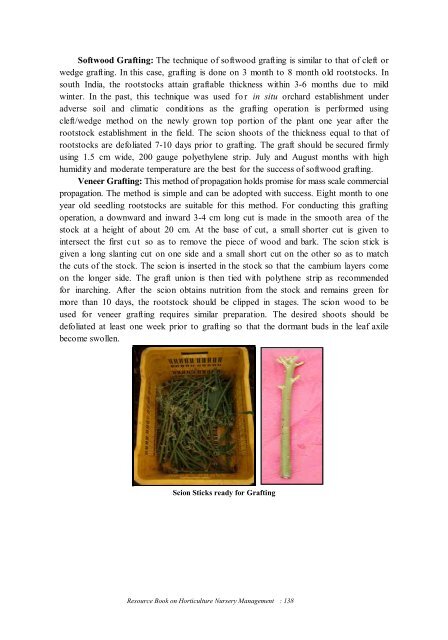Resource Book on Horticulture Nursery Management
Resource Book on Horticulture Nursery Management
Resource Book on Horticulture Nursery Management
Create successful ePaper yourself
Turn your PDF publications into a flip-book with our unique Google optimized e-Paper software.
Softwood Grafting: The technique of softwood grafting is similar to that of cleft or<br />
wedge grafting. In this case, grafting is d<strong>on</strong>e <strong>on</strong> 3 m<strong>on</strong>th to 8 m<strong>on</strong>th old rootstocks. In<br />
south India, the rootstocks attain graftable thickness within 3-6 m<strong>on</strong>ths due to mild<br />
winter. In the past, this technique was used fo r in situ orchard establishment under<br />
adverse soil and climatic c<strong>on</strong>diti<strong>on</strong>s as the grafting operati<strong>on</strong> is performed using<br />
cleft/wedge method <strong>on</strong> the newly grown top porti<strong>on</strong> of the plant <strong>on</strong>e year after the<br />
rootstock establishment in the field. The sci<strong>on</strong> shoots of the thickness equal to that of<br />
rootstocks are defoliated 7-10 days prior to grafting. The graft should be secured firmly<br />
using 1.5 cm wide, 200 gauge polyethylene strip. July and August m<strong>on</strong>ths with high<br />
humidity and moderate temperature are the best for the success of softwood grafting.<br />
Veneer Grafting: This method of propagati<strong>on</strong> holds promise for mass scale commercial<br />
propagati<strong>on</strong>. The method is simple and can be adopted with success. Eight m<strong>on</strong>th to <strong>on</strong>e<br />
year old seedling rootstocks are suitable for this method. For c<strong>on</strong>ducting this grafting<br />
operati<strong>on</strong>, a downward and inward 3-4 cm l<strong>on</strong>g cut is made in the smooth area of the<br />
stock at a height of about 20 cm. At the base of cut, a small shorter cut is given to<br />
intersect the first cut so as to remove the piece of wood and bark. The sci<strong>on</strong> stick is<br />
given a l<strong>on</strong>g slanting cut <strong>on</strong> <strong>on</strong>e side and a small short cut <strong>on</strong> the other so as to match<br />
the cuts of the stock. The sci<strong>on</strong> is inserted in the stock so that the cambium layers come<br />
<strong>on</strong> the l<strong>on</strong>ger side. The graft uni<strong>on</strong> is then tied with polythene strip as recommended<br />
for inarching. After the sci<strong>on</strong> obtains nutriti<strong>on</strong> from the stock and remains green for<br />
more than 10 days, the rootstock should be clipped in stages. The sci<strong>on</strong> wood to be<br />
used for veneer grafting requires similar preparati<strong>on</strong>. The desired shoots should be<br />
defoliated at least <strong>on</strong>e week prior to grafting so that the dormant buds in the leaf axile<br />
become swollen.<br />
Sci<strong>on</strong> Sticks ready for Grafting<br />
<str<strong>on</strong>g>Resource</str<strong>on</strong>g> <str<strong>on</strong>g>Book</str<strong>on</strong>g> <strong>on</strong> <strong>Horticulture</strong> <strong>Nursery</strong> <strong>Management</strong> : 138











